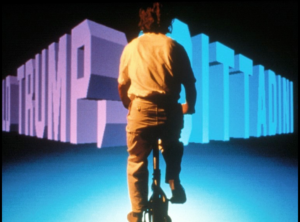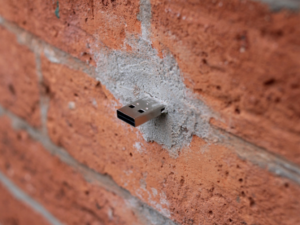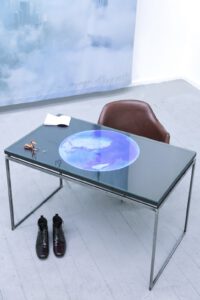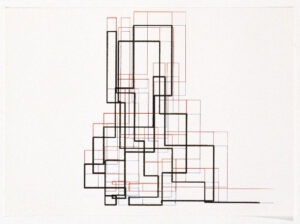Collectible Digital Art
One thing is certain: the digital revolution has conquered us. We - the people, whether we like it or not - are being inexorably digitally transformed. Terms related to digitalisation are 1000-fold, conferences like the Digital Summit, DLD, the Digital Health Conference are proliferating, initiatives like "Digital for All" ensure more equality within social classes, digital lifestyle / digital households are hip, cryptocurrencies enable digital payments, home office and home schooling have gained momentum in times of Corona, digital twins cry out for reproduction of the ego, digital engineering improves planning quality, digital love revives the porn industry, doctors' surgeries diagnose digital dementia, digital natives are the new digital natives, digital heritage takes care of their Facebook, Snapchat or Instagram accounts postmortem, and the D21 Digital Index tries to understand all this, namely the Digital Society as a whole.
In short: the world is digital!
"The only constant in life is change" - Heraclitus' insight still holds true after two and a half thousand years, as the progress of technological developments shows.
However, the digital transformation of our lives is much more profound than the Industrial Revolution, to the extent that future scenarios such as the extinction of Homo Sapiens and the emergence of new, immortal creatures with the help of biotechnology and artificial intelligence no longer seem quite as far-fetched as they did a century ago.
And this is where contemporary artists come into play. For they are always responding to the world born into it through artistic means and are most able to absorb, express or criticise what is happening around us.
Artists are the true seismographs in social transformation processes!
Digital thoughts in art have existed since before the first computers were connected to power networks.
Here w ego: 10 milestones of digital art - briefly presented:
Frider Nake
When the first scientists began to use computers to create graphics in the early 1960s (especially in the field of NASA space surveillance), the first artists also realised exhibitions with computer drawings. The pioneer Frieder Nake, along with Manfred Mohr or Vera Molnar, was active from the beginning and still programs what the computer should draw. His revolutionary, mathematically sophisticated graphics are in extreme demand today. "Random Polygon Train, 25.2.65" from 1965 is a coloured plotter drawing in which the pen plotter consistently followed the algorithm developed by the artist himself via information processing by the computer.
John Whitney
The first computer animations were created by experimental artists such as John Whitney. In the beginning, it was about visualising music through electronic media. Together with his brother, he developed techniques and invented machines to make this possible. The result was expressive animations in abstract design with the typical feasible aesthetics of the time. "Permutations" from 1968 can be viewed on YouTube today. It is based on the idea of pixelation and shows animated dots creating a dance of the patterns of a room. Animation meant the future of art for John Whitney.
Jeffrey Shaw The interactive installation "The Legible City" by Jeffrey Shaw, 1988-91, caused a great stir.
The interactive installation "The Legible City" by Jeffrey Shaw, 1988-91, caused a great stir.
It consists of software, a computer, a projection screen and a bicycle on which the actor sits and actively navigates through a virtual city. The city does not consist of houses, but of letters that form themselves into words. By slowly moving forward, sentences are created. On the way through the respective city, the driver can follow entire narrative leaps. Today, the version of Manhattan is considered a key work in the field of interactive installation.
Nam June Paik
Nam June Paik is the only artist in the world who has worked continuously with video and television since the early 1960s. The beauty of his works is that they are technically innovative and at the same time a humorous critique of technology. Probably Paik's best-known video work, the "TV Buddah" (1974) is simple and ingenious at the same time: an antique Buddha statue is juxtaposed with a television monitor and the image of the Buddha is transmitted live on the monitor. The statue, which is turned towards meditation, thus becomes a symbol of the search for absolute emptiness outside of time and space; the installation refers to itself. There is digital thought transfer. To this day, the work has been received in constantly modified form by an infinite number of artists.
Joan Heemskerk & Dirk Peasmans  To trace the beginnings of net art, you don't have to go to a museum. All you have to do is switch on your computer and type the following address into your browser: wwwwwwwww.jodi.org /
To trace the beginnings of net art, you don't have to go to a museum. All you have to do is switch on your computer and type the following address into your browser: wwwwwwwww.jodi.org /
Punctuation marks and numbers flash in bright green against a black background. The internet page does not make sense even after a longer look. The resolution lies in the source text. This is read by the browser and shows numbers, dots and slashes that together form the outline of a hydrogen bomb. This page was created in 1993 by the artist duo Joan Heemskerk & Dirk Peasmans. It shows very early on that the popular medium of the Internet is not only a form of global communication, but can also be understood as an artistic tool. In addition, it points out the dangers that can lurk behind the surface of the internet.
Cory Arcangel
Cory Arcangel is an artist who addresses the relationships between technologies and culture in a variety of media. His ROM hacking works fall into the realm of hacktivism. Their aesthetics are based on the computer technology of the 70s and 80s. For example, Arcangel uses historical Nintendo entertainment systems and manipulates their software. The work "Clouds" (2002) is based on the famous video game Super Mario Bros, in whose hacked version all graphics were deleted and only the iconic clouds were retained, which now float back and forth in their coarse pixelation against a brilliant blue background.
Olia Lialina
Olia Lialina is one of the most famous net.art artists of her time. The work "My Boyfriend Came Back from the War", 1996 consists of a system of multiplying frames, few low-resolution images, terse sentences and a black-and-white look. It is about the war and the difficult encounters after the war. The dialogue itself is not easy. And depending on which frame the user decides on, the story - analogous to a hypertext - proceeds very differently. This groundbreaking piece of net art has inspired its successor generations to imitate it in many ways.
Aram Bartholl Post-Internet Art was a term widely used a few years ago, which - contrary to its name - makes the Internet and its culture its subject like no other art movement. Post-Internet-Artistst revolve around the influence of the digital on the technologically driven society by transferring net-dependent worlds into the realm of offline life, i.e. into the physical world. Aram Bartholl is one of them. "Dead Drops" is an offline-based global peer-to-file sharing network in public space that the artist first realised in New York in 2010. Using putty, USB drives are mortared into walls and made usable for the general public, so that anyone passing by with a notebook can pull or leave digital data from the "Dead Drops". Internet access is neither necessary nor desirable for sharing this data. On the contrary, his Dead Drops bypass any online surveillance and enable the undisturbed transfer of data.
Post-Internet Art was a term widely used a few years ago, which - contrary to its name - makes the Internet and its culture its subject like no other art movement. Post-Internet-Artistst revolve around the influence of the digital on the technologically driven society by transferring net-dependent worlds into the realm of offline life, i.e. into the physical world. Aram Bartholl is one of them. "Dead Drops" is an offline-based global peer-to-file sharing network in public space that the artist first realised in New York in 2010. Using putty, USB drives are mortared into walls and made usable for the general public, so that anyone passing by with a notebook can pull or leave digital data from the "Dead Drops". Internet access is neither necessary nor desirable for sharing this data. On the contrary, his Dead Drops bypass any online surveillance and enable the undisturbed transfer of data.
Niko Abramidis & NE  Niko Abramidis & NE has made the transformation processes mentioned at the beginning its main theme. With a view to the current digital and economic processes, he imitates the visual language of large companies and creates his own ciphers, logis, icons, shares, quarterly reports, cryptocurrencies and even completely furnished offices. The "3000 Years Agenda Desk" is such a fictitious office, the tabletop of the desk consists of a flat screen that keeps a very close eye on the global financial metropolises via google earth, while an Anubis sculpture and a small circle refer to the economies of the ancient Egyptians. A pair of polished business shoes and a suit recall the performance of the artist who once served as the boss of the office and kept an eye on the company's fortunes.
Niko Abramidis & NE has made the transformation processes mentioned at the beginning its main theme. With a view to the current digital and economic processes, he imitates the visual language of large companies and creates his own ciphers, logis, icons, shares, quarterly reports, cryptocurrencies and even completely furnished offices. The "3000 Years Agenda Desk" is such a fictitious office, the tabletop of the desk consists of a flat screen that keeps a very close eye on the global financial metropolises via google earth, while an Anubis sculpture and a small circle refer to the economies of the ancient Egyptians. A pair of polished business shoes and a suit recall the performance of the artist who once served as the boss of the office and kept an eye on the company's fortunes.
Gabriel Barcia-Colombo
Gabe BC is a mixed media artist best known for creating living video installation pieces of "miniature humans" that live their hologrammed lives enclosed in ordinary objects such as suitcases or blenders. To raise awareness of privacy issues related to the use of human DNA and the biotechnological possibilities of today, in 2014 he created the "DNA Vending Machine", a commercially available vending machine from which human genetic material can be drawn. Human DNA thus becomes a collector's item and at the same time addresses current legal issues concerning our valuable genetic information.
Winslow Porter
Outstanding art stands and falls with the implementation and the concept behind it. One of the most impressive VR works is the award-winning "Tree" VR tree by the artist Winslow Porter & Team. Tree transforms the user into a rainforest tree, whose growth he can experience live and with all his senses, from the seed in deep soil to the fully grown tree crown. The work not only impresses with its overwhelming visual and equally technically convincing representation of the rainforest. It also makes a critical reference to the climate catastrophe caused by us humans by exposing the rainforest to a blazing fire that can be physically felt within the VR experience (through the heat and smell of an externally flared match). The work was created in collaboration with the Rainforest Alliance and simultaneously appeals for donations to bring the earth back into balance.
